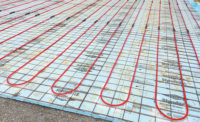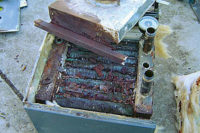During three decades of dealing with hydronic systems, I’ve had my share of opportunities to watch systems that worked great and even greater opportunities to look at systems that delivered more surprises than heat.
Like anyone who considers themselves a pro, I’ve done the forensics on the problem jobs to avoid making the same mistakes twice. The lessons learned were applied to future designs and incorporated into training programs that have evolved over time.
These experiences have confirmed two behaviors common to all hydronic systems. Both are rooted in the tenants of thermodynamics. Neither should be thought of as some mysterious phenomena. When understood and respected, these behaviors unfailingly reveal why a given system does what it does. This knowledge can be a real asset for designing as well as troubleshooting hydronic systems.
Who’s in charge?
Fundamentally, there are two things that every hydronic system you’ll ever design or install “wants” to do. They all want to operate at simultaneous conditions called thermal equilibrium and hydraulic equilibrium. Both conditions represent a balance between energy input and energy release.
Thermal equilibrium is a condition in which every system tries to operate so the rate of heat input to the water from the heat source (boiler, heat pump, etc.) is exactly the same as the rate of heat release from the heat emitters. The supply water temperature and temperature drop the system stabilizes at always are those necessary to balance these rates of heat transfer. In some situations these temperatures can be significantly higher or lower than what we expect based on control settings.
Consider the system in Figure 1. The boiler delivers heat at a rate of 50,000 Btu/hr. to the circulating water. The distribution system is a series loop with 154 ft. of residential fin-tube baseboard. The boiler’s high-limit controller is set to turn the boiler off if the water temperature leaving the heat source reaches 200° F.
When the system is put into operation, the water leaving the boiler steadily climbs to 160° F and stabilizes at that temperature. Thus, the system reaches thermal equilibrium at 160° F, (e.g., reaches thermal equilibrium). At this temperature, the 50,000 Btu/hr. being added to the circulating water by the boiler is being dissipated from the water as it passes through the 154 ft. of baseboard.
This supply water temperature is 40° lower than the temperature at which the boiler’s high-limit controller will stop further heat production. Even if the boiler’s high-limit controller was set for 250° F, the supply water temperature would not climb higher than 160° F. The water temperature doesn’t need to climb any higher to balance the rate of heat generation by the heat source with the rate of heat dissipation by the distribution system.
Imagine an installer watching this situation. After an hour or two of steady boiler operation, the water temperature leaving the boiler refuses to climb higher than 160° F. The installer thinks there’s something wrong because the boiler is not reaching the temperature he “told it to” by setting the limit controller to 200° F. He grabs a wrench and whacks the limit controller a couple of times to show who’s in charge. After another hour, the boiler is still purring along at 160° F outlet temperature.
The frustrated installer has had enough. He shuts off the system and pulls the limit controller off the boiler. Next stop … his local supplier where he demands a replacement for the “obviously defective” controller.
But there’s nothing wrong with that controller. Hopefully, the person he speaks to at the counter can calm him down and explain the high-limit controller is simply a switch to turn off the burner if the water temperature reaches the setting on the controller. It doesn’t guarantee the boiler will ever reach that setting temperature.
The concept of thermal equilibrium is a powerful guide for those designing hydronic heating systems. The design objective is to ensure that when thermal equilibrium is established, the system operates at conditions that provide excellent comfort and do not adversely affect the operation, safety or longevity of the system’s components.
Flow fundamentals
There’s another form of energy constantly being put into and dissipated from hydronic systems as they operate — mechanical energy called “head.” An operating circulator converts some of the electrical energy supplied to it into head energy and imparts that energy to the fluid. The remaining portion of the electrical energy supplied to the circulator is converted into heat. At the same time, every component through which flow passes removes head energy because of friction between water molecules, and between those molecules and the surfaces of the components the fluid is passing through.
The system always stabilizes at a flow rate where the rate of head-energy input exactly matches the rate of head-energy dissipation. This is called “hydraulic equilibrium,” and it usually is achieved within a few seconds of turning on the circulator. The concept of hydraulic equilibrium is illustrated in Figure 2.
The system remains at the equilibrium conditions until the system curve or pump curve changes. The system curve would change due to a valve adjustment, a zone-valve opening or closing, and to a lesser extent by changes in the fluid’s density and viscosity as it warms up or cools down. The pump curve would change if the circulator changes speed. When and if such changes occur, the system quickly settles to a new flow rate where head input from the circulator matches head loss from the currently configured piping system.
You can predict the condition at which hydraulic equilibrium will occur. It’s done by first constructing a system head-loss curve and then overlaying it with the pump curve of a circulator you might be considering for the system. An example is shown in Figure 3.
The point where these curves cross is called the operating point and is the only possible condition where head input exactly balances head dissipation. In other words, this is the point where hydraulic equilibrium occurs.
You’ve heard that nature likes a balance. This is perfectly illustrated through both thermal and hydraulic equilibrium in all hydronic systems. Our task as designers is to ensure the system also delivers the desired comfort while it seeks to operate at both thermal and hydraulic equilibrium.
When you ponder the operation of your systems from these standpoints it all makes sense.
HELPFUL LINKS:







